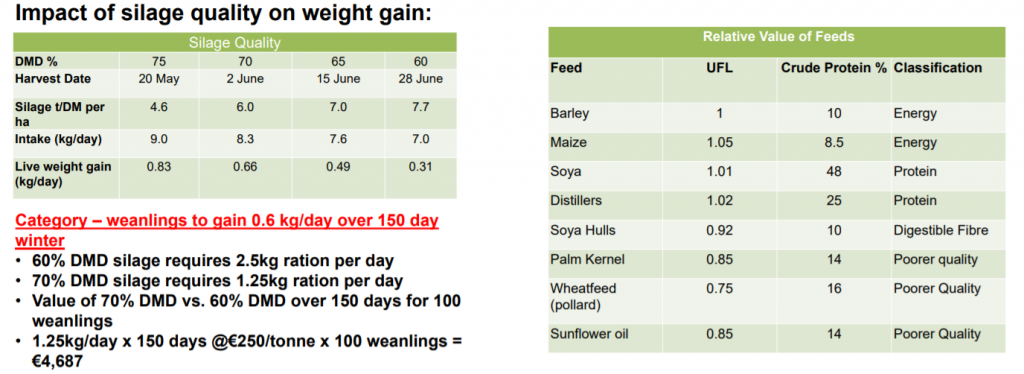Achieving an adequate level of weight gain over the course of the first winter is critical in ensuring that weight targets continue to be met and profitability is maximised on dairy calf-to-beef systems.
The targeted average daily gain (ADG) over the first winter is 0.6kg/day, as this allows for cheap liveweight gain to be achieved at grass at the start of the second grazing season.
If winter daily gains fall to 0.25kg/day or less, animals will become stunted and this will have a knock-on effect on the system further down the line.
Targeting a moderate level of winter thrive – such as 0.6kg/day – is dependent on having animals on target at housing time, weighing a minimum of 210kg. Animals need to be hitting this target and have an ADG of 0.6kg/day over the course of a 120-day winter in order to reach the target turnout weight of 280kg.
Speaking at an open day on Teagasc Green Acres Calf to Beef Programme participants Thomas and Peter O’Hanrahan’s farm in Co. Kilkenny, Alan Dillon outlined the importance of good-quality silage and the ingredients to be looking out for in both weanling and finishing rations.
“We are still seeing silage quality hitting 60-65% dry matter digestibility (DMD) across the board. But, what is this silage capable of doing? – a daily liveweight of 0.3-0.4kg/day for weanlings, but our daily liveweight target is 0.6kg/day,” Alan explained.
Silage quality on Peter’s farm has come in somewhere in the region of 74-75% DMD over the past number of years, with second-cut silage hitting 66-68% DMD.
“If you have 75% DMD, you will achieve a daily liveweight gain of 0.8-0.85kg/day on silage only.
“If we are to put a value on that – what’s that worth? If you were to look at the difference between 60-70% DMD silage, you would have to feed 1.25kg of meal extra/day to achieve the target weight gain, rather than if you were feeding 70% DMD silage.
“Over a 150-day winter (depending on the year), considering 100 weanlings, it’s worth somewhere near €5,000 of a saving by cutting your silage that bit earlier,” Alan added.
Completing silage analysis is critical to ensure that the weanlings’ nutritional requirements are met and that the desired level of performance is achieved over the winter period.
Touching on ration ingredients, he said: “Energy is what will put fat onto cattle – that’s what you need. If you’re buying a finishing ration, barley and maize are the ingredients you are looking for.
“Protein feeds include soybean meal or distillers, while soya hulls are digestible fibres that are good for rumen function. If you look at the ingredients in a ration and you see palm kernel, wheat feed (pollard) and sunflower oil near the top of the list, you should be questioning what you are buying,” Alan highlighted.
“When you are looking at your rations, you want to see either barley or maize in the top two or three ingredients, then protein in terms of a soybean meal or distillers, but preferably soybean meal; you need digestible fibers such as soya hulls as well,” he concluded.
Liffey Mill’s Willie Boland also discussed the importance of a good-quality ration. He said: “One thing to remember when you are feeding cattle – they are a ruminant animal.
“If we break down what this type of animal wants – they need energy, they need protein and they need fibre,” Willie said.
An example of a weanling and finisher ration – along with prices – are listed below.



